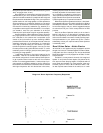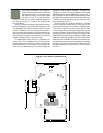
letting Room Optimizer search out different solutions (just hit
“start” and go get a beer, or two).
Room Optimizer is concerned only with the low-frequency
characteristics of your room. Its search is based upon the fre-
quencies from 20 Hz to 300 Hz. It is possible to set the high and
low points within that 20-300 Hz range. Thus, you may seek an
optimal location for a full-range speaker or a main speaker that
will be crossed over to a subwoofer. Similarly, you can set the
upper limit so that search is concerned only with the frequen-
cies that will be covered by a subwoofer (e.g., 20-80 Hz). It is
not possible to set the upper limit below 80 Hz, if, for example,
you wanted to cross over your subwoofer at 40 Hz (the
crossover point I prefer when using full range main speakers).
Another limitation of Room Optimizer is that it assumes a
fairly rigid symmetrical room. Its formula includes an absorp-
tion coefficient for the surfaces that is comparable to the
amount of flex in the walls of my room. According to RPG’s
president Peter D’Antonio, at low frequencies most rooms are
essentially rectangular, so the assumption of a rectangular
room might not be as limiting as it first seems. If you don’t
take Room Optimizer’s results as gospel – how can you when
the same problem usually yields different results? – it can be
remarkably useful in finding a good (and close) starting spot
for placing full-range speakers.
I used Room Optimizer to find initial locations for the
Thiel MCS-1, Thiel CS 7.2, and Revel Salon loudspeakers in
two-channel configurations. In each instance, Room Optimiz-
er got me within several inches on each axis of an excellent
location. From the suggested location, I used a variety of pro-
gram material as I moved the speakers to and fro, listening to
the extension and smoothness of the bass as well as its blend
with higher frequencies. As I will discuss later in this series,
matching the performance of the two channels
as closely as possible is instrumental in attain-
ing outstanding soundstaging performance.
Thus, symmetrical location within the room is
highly desirable. Room Optimizer automatical-
ly sets the speakers up in symmetrical locations.
When Room Optimizer generates a solution, it also identi-
fies suggested locations on your walls and ceiling for diffusive
and absorptive materials. These are materials that RPG will
be more than happy to sell you, and the suggested locations
are rational and not just a clever cross-promotion for RPG
products.
Here we set Room Optimizer aside, but do not leave it
behind. It will return in our discussions of subwoofer set-up
and, more importantly, surround speaker set-up. Beware: You
cannot use the software as a means of totally avoiding empir-
ical experimentation in your speaker set-up. But if used to
substantially narrow your empirical search, Room Optimizer
is remarkably useful.
Revel Ultima Salon – Noble Warrior
At first blush, it isn’t apparent why any loudspeaker could be
thought of as a warrior in the battle against The Room. Rather,
it may seem more like a casualty of war. And yet the $14,200
Revel Ultima Salon is not only equipped to do battle, it is well
suited to the task.
The Salon is, in every sense of the word, a full-range loud-
speaker. It can plumb the lower depths (way below 30 Hz)
with ease and reach dizzying heights of amplitude without
strain. Revel rates the Salon’s “in room response” (their mea-
surement) as plus or minus 1 dB from 25 Hz to 18 kHz. I real-
ize that response seems limited in the treble, but it is well
Diagram 2: Room Optimizer Frequency Responses


















